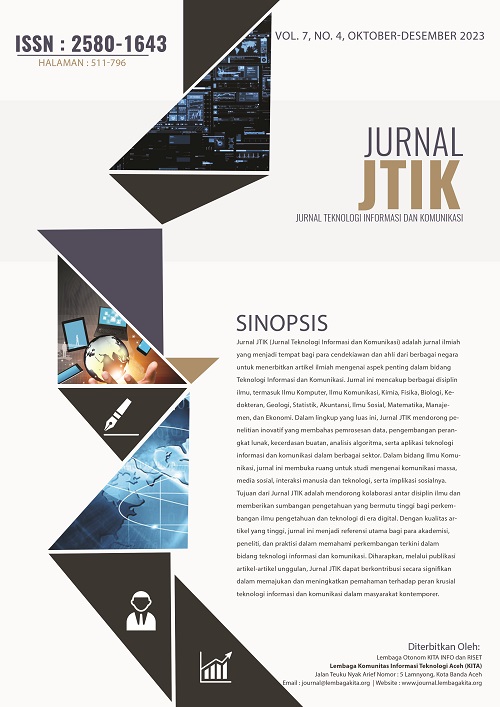Klasifikasi Data Penderita Skizofrenia Menggunakan CNN-LSTM dan CNN-GRU pada Data Sinyal EEG 2D
Main Article Content
Abstract
Schizophrenia (SZ) is a brain disease with a chronic condition that affects the ability to think. Common symptoms that are often seen in SZ patients are hallucinations, delusions, abnormal behavior, speech disorders, and mood disorders. SZ patients can be diagnosed using electroencephalographic (EEG) signals. This study conducted a comparative analysis of the best method in EEG classification using the Deep Learning (DL) method. The author uses the 2D Convolutional Neural Network (2D-CNN) method with different layers. The first 2D-CNN uses a layer of Long Short Term memory(LSTM) and Gate Recurrent Unit(GRU). The dataset used consists of two types of EEG signals obtained from 39 healthy individuals and 45 schizophrenic patients during a resting state. Test results for the accuracy of the F1-score from 5 times testing the CNN method using the LSTM layer has the best accuracy value of 94.12% and 5 times testing the CNN method using the GRU layer has the best accuracy value of 94.12%.
Downloads
Article Details

This work is licensed under a Creative Commons Attribution-NonCommercial 4.0 International License.
References
Aydemir, E., Dogan, S., Baygin, M., Ooi, C.P., Barua, P.D., Tuncer, T. and Acharya, U.R., 2022, March. CGP17Pat: automated schizophrenia detection based on a cyclic group of prime order patterns using EEG signals. In Healthcare (Vol. 10, No. 4, p. 643). MDPI. DOI: https://doi.org/10.3390/healthcare10040643.
Shalbaf, A., Bagherzadeh, S. and Maghsoudi, A., 2020. Transfer learning with deep convolutional neural network for automated detection of schizophrenia from EEG signals. Physical and Engineering Sciences in Medicine, 43, pp.1229-1239. DOI: https://doi.org/10.1007/s13246-020-00925-9.
Afrooz, E. and Taghavi, M., 2022. Information-Theoretic Analysis of EEG Signals to Differentiate Schizophrenic Patients with Positive and Negative Symptoms and Control Group. Iranian Journal of Psychiatry and Behavioral Sciences, 16(3). DOI: https://doi.org/10.5812/ijpbs-118000.
Calhas, D., Romero, E. and Henriques, R., 2020. On the use of pairwise distance learning for brain signal classification with limited observations. Artificial intelligence in medicine, 105, p.101852. DOI: https://doi.org/10.1016/j.artmed.2020.101852.
Aslan, Z. and Akin, M., 2020. Automatic Detection of Schizophrenia by Applying Deep Learning over Spectrogram Images of EEG Signals. Traitement du Signal, 37(2). DOI: https://doi.org/10.18280/ts.370209.
Fadel, W., Kollod, C., Wahdow, M., Ibrahim, Y. and Ulbert, I., 2020, February. Multi-class classification of motor imagery EEG signals using image-based deep recurrent convolutional neural network. In 2020 8th International Winter Conference on Brain-Computer Interface (BCI) (pp. 1-4). IEEE. DOI: https://doi.org/10.1109/BCI48061.2020.9061622.
Singh, K., Singh, S. and Malhotra, J., 2021. Spectral features based convolutional neural network for accurate and prompt identification of schizophrenic patients. Proceedings of the Institution of Mechanical Engineers, Part H: Journal of Engineering in Medicine, 235(2), pp.167-184. DOI: https://doi.org/10.1177/0954411920966937.
Torres Naira, C.A., 2020. Classification of people who suffer schizophrenia and healthy people by EEG signals using Deep Learning. Int. J. Adv. Comput. Sci. Appl., vol. 10, no. 10, pp. 511–516, 2019, DOI: https://doi.org/10.14569/ijacsa.2019.0101067.
Phang, C.R., Ting, C.M., Noman, F. and Ombao, H., 2019. Classification of EEG-based brain connectivity networks in schizophrenia using a multi-domain connectome convolutional neural network. arXiv preprint arXiv:1903.08858. DOI: https://doi.org/10.1109/JBHI.2019.2941222.
Rong, Y., Wu, X. and Zhang, Y., 2020. Classification of motor imagery electroencephalography signals using continuous small convolutional neural network. International Journal of Imaging Systems and Technology, 30(3), pp.653-659. DOI: https://doi.org/10.1002/ima.22405.
Balam, V.P., Sameer, V.U. and Chinara, S., 2021. Automated classification system for drowsiness detection using convolutional neural network and electroencephalogram. IET Intelligent Transport Systems, 15(4), pp.514-524. DOI: https://doi.org/10.1049/itr2.12041.
Zhao, B., Lu, H., Chen, S., Liu, J. and Wu, D., 2017. Convolutional neural networks for time series classification. Journal of Systems Engineering and Electronics, 28(1), pp.162-169. DOI: https://doi.org/10.21629/JSEE.2017.01.18.
Saeedi, M., Saeedi, A. and Mohammadi, P., 2022. Schizophrenia Diagnosis via FFT and Wavelet Convolutional Neural Networks utilizing EEG signals. DOI: https://doi.org/10.21203/rs.3.rs-1497490/v1.
Lu, W., Li, J., Li, Y., Sun, A. and Wang, J., 2020. A CNN-LSTM-based model to forecast stock prices. Complexity, 2020, pp.1-10. DOI: https://doi.org/10.1155/2020/6622927.
Nguyen, V., Cai, J. and Chu, J., 2019, August. Hybrid CNN-GRU model for high efficient handwritten digit recognition. In Proceedings of the 2nd international conference on artificial intelligence and pattern recognition (pp. 66-71). DOI: https://doi.org/10.1145/3357254.3357276.

